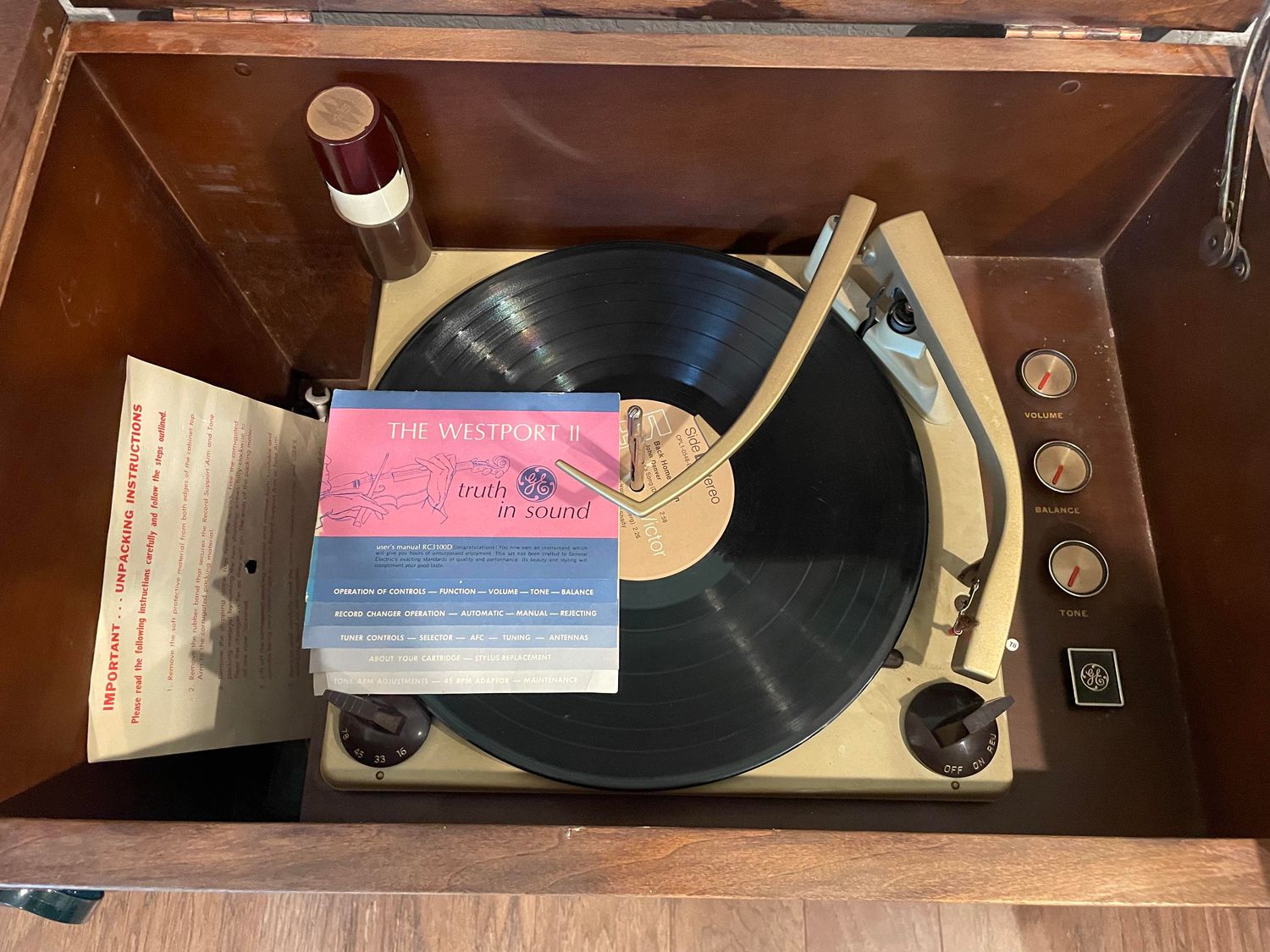Home>Devices & Equipment>Turntable>How To Refurbish An Old Turntable


Turntable
How To Refurbish An Old Turntable
Published: January 18, 2024
Learn how to refurbish and restore an old turntable to its former glory with our step-by-step guide. Discover tips and techniques to bring new life to your beloved turntable.
(Many of the links in this article redirect to a specific reviewed product. Your purchase of these products through affiliate links helps to generate commission for AudioLover.com, at no extra cost. Learn more)
Table of Contents
- Introduction
- Step 1: Assessing the condition of the old turntable
- Step 2: Gathering the necessary tools and materials
- Step 3: Cleaning the turntable
- Step 4: Replacing the cartridge and stylus
- Step 5: Lubricating the moving parts
- Step 6: Restoring the exterior
- Step 7: Testing the refurbished turntable
- Conclusion
Introduction
The turntable, also known as a record player, has been a staple in the world of music for decades. With its ability to play vinyl records, it offers a unique and nostalgic listening experience that many audiophiles still enjoy today. If you happen to stumble upon an old turntable tucked away in the attic or find one at a thrift store, you may be wondering if it’s possible to bring it back to life.
In this article, we will guide you through the process of refurbishing an old turntable. Whether you are a vintage enthusiast or just starting to explore the world of vinyl, restoring an old turntable can be a rewarding and cost-effective way to enjoy your favorite records.
Refurbishing an old turntable involves a few key steps. First, you need to assess the condition of the turntable to determine if it’s worth restoring. Next, you’ll need to gather the necessary tools and materials to perform the refurbishment. Then, you’ll clean the turntable, replace the cartridge and stylus, lubricate the moving parts, and restore the exterior. Finally, you’ll test the refurbished turntable to ensure it’s functioning properly.
Throughout this guide, we’ll provide detailed instructions and tips to help you along the way. So, dust off that old turntable and let’s dive into the exciting world of turntable refurbishment!
Step 1: Assessing the condition of the old turntable
Before diving into the refurbishment process, it’s essential to assess the condition of the old turntable. This step will help you determine if it’s worth restoring and give you an idea of the work that needs to be done.
Start by visually inspecting the turntable. Look for any signs of damage, such as cracks or chips in the body, loose or missing parts, or excessive dust and dirt accumulation. Take note of any noticeable issues that need to be addressed during the refurbishment.
Next, examine the turntable’s mechanical components. Check if the platter spins smoothly and without wobbling. Listen for any unusual noises or vibrations when you turn it on or adjust the speed. Examine the tonearm for any signs of damage or stiffness. Ensure that the tonearm lift mechanism is working correctly.
Inspect the wiring and connections. Look for any exposed or frayed wires, loose connections, or signs of corrosion. Additionally, check the power switch, speed control, and any other controls to ensure they are functioning properly.
Take a close look at the cartridge and stylus. Check if they are intact and undamaged. If there are any issues with the cartridge or stylus, they will likely need to be replaced.
Finally, consider the overall condition of the turntable aesthetically. Are there any scratches, discoloration, or signs of wear on the body or the dust cover? While cosmetic issues can be purely visual, they may also indicate potential underlying problems.
Based on your assessment, determine if the turntable is worth refurbishing or if it might require extensive repairs that are beyond your expertise. It’s crucial to realistically evaluate the time, effort, and cost involved in the refurbishment process.
Remember, the condition of the turntable will ultimately dictate the success and enjoyment you’ll get from the refurbished product. So, take your time during this assessment process to make an informed decision before moving forward with the refurbishment.
Step 2: Gathering the necessary tools and materials
Once you’ve assessed the condition of your old turntable and decided to proceed with the refurbishment, the next step is to gather all the necessary tools and materials. Having the right equipment on hand will make the process smoother and more efficient.
Here’s a list of essential tools and materials you’ll likely need:
- Screwdriver set: You’ll need a set of screwdrivers with various sizes and types, including flathead and Phillips-head, to remove and tighten screws on the turntable.
- Pliers: Pliers can come in handy for gripping and manipulating small parts, especially if they are rusted or tightly secured.
- Tweezers: Tweezers will allow you to handle delicate parts and wires with precision.
- Cleaning solutions: Depending on the level of dirt and grime, you may need different cleaning solutions. Isopropyl alcohol is commonly used for cleaning electronic components, while a mild soap solution can be used for cleaning the turntable’s exterior.
- Cotton swabs and lint-free cloths: These items are ideal for applying cleaning solutions and removing dust, dirt, and residue from various parts of the turntable.
- Replacement cartridge and stylus: If your assessment determined that the cartridge and stylus need to be replaced, make sure to have suitable replacements ready. Research the compatibility with your turntable model to ensure a proper fit.
- Lubricant: A silicone-based lubricant can be used to lubricate moving parts, such as the spindle bearing and tonearm pivot.
- Small brush: A small brush, such as a soft-bristled paintbrush or a dedicated turntable brush, can be used to gently remove loose dust and debris from the turntable’s surface.
- Anti-static cleaning products: To minimize static electricity buildup, consider investing in an anti-static carbon fiber brush or an anti-static mat.
Remember to check your specific turntable model and any additional recommendations or requirements from the manufacturer. There may be specialized tools or materials needed that are specific to your turntable.
By gathering these tools and materials ahead of time, you’ll be prepared to tackle each step of the refurbishment process efficiently and ensure that you have everything you need to restore your old turntable to its former glory.
Step 3: Cleaning the turntable
Now that you have gathered the necessary tools and materials, it’s time to dive into the cleaning process. Cleaning the turntable is an essential step in the refurbishment process, as it removes dirt, dust, and grime that can affect the performance and longevity of the components.
Here’s a step-by-step guide to cleaning your turntable:
- Disconnect the turntable: Before starting any cleaning, make sure the turntable is disconnected from the power source. This will prevent any accidental damage or electrical hazards.
- Remove the dust cover and platter: Gently lift off the dust cover and set it aside. Next, remove the platter by lifting it straight up. Some turntables may have a locking mechanism or screws holding the platter in place, so refer to your turntable’s manual for specific instructions.
- Clean the dust cover: Clean the dust cover with a mild soap solution or a non-abrasive cleaner. Use a lint-free cloth to wipe away the dirt and grime. Avoid using harsh chemicals or abrasive materials that can cause scratches.
- Clean the platter: Use a soft cloth or microfiber cloth to wipe off any dust or debris from the platter. If there are any stubborn stains or residue, you can use a gentle cleaning solution. Ensure that the platter is completely dry before reattaching it to the turntable.
- Clean the tonearm: Use a cotton swab lightly dampened with isopropyl alcohol to clean the tonearm. Gently wipe away any dirt or residue, being careful not to apply excessive pressure or force that could damage the delicate parts.
- Clean the cartridge and stylus: If the cartridge and stylus are in good condition, use a soft brush or a dedicated stylus cleaning brush to remove any dust or debris. Be gentle and avoid touching the stylus with your fingers, as oils from your skin can affect its performance. If the cartridge or stylus needs replacement, refer to the manufacturer’s instructions on how to properly install the new ones.
- Clean the exterior: Use a soft cloth or microfiber cloth to clean the exterior of the turntable. If there are any stubborn stains or marks, you can use a mild soap solution. Avoid excessive moisture and be mindful of any sensitive labels or decals that could be easily damaged.
Once you have thoroughly cleaned all the components, allow them to dry completely before reassembling the turntable. Remember to handle each part with care to avoid unnecessary damage or scratches.
By cleaning your turntable, you not only improve its appearance but also ensure optimal performance and longevity. A clean turntable will provide a better sound quality and minimize any potential issues caused by dirt or dust buildup.
Step 4: Replacing the cartridge and stylus
Replacing the cartridge and stylus is a crucial step in the refurbishment process, especially if your assessment determined that they are worn out or damaged. The cartridge and stylus are responsible for translating the grooves of the vinyl record into audio signals, so ensuring their proper functioning is essential for optimal sound quality.
Here’s a step-by-step guide on how to replace the cartridge and stylus:
- Refer to the turntable manual: Consult your turntable’s manual or look up the manufacturer’s instructions for specific guidance on replacing the cartridge and stylus. Different turntable models may have different methods of installation.
- Prepare the new cartridge and stylus: Unpack the new cartridge and stylus carefully, taking note of any installation instructions or recommendations provided by the manufacturer. Make sure you have the correct replacement parts that are compatible with your turntable model.
- Remove the old cartridge and stylus: Some turntables have a removable headshell, while others require removing the cartridge directly. Follow the instructions in the manual to detach the old cartridge and stylus safely. Take note of the wiring connections and how they are connected.
- Install the new cartridge and stylus: Align the new cartridge and stylus according to the manufacturer’s instructions. Ensure that they are properly seated and secured. Reconnect the wiring connections, making sure they match the previous setup.
- Check the tracking force and alignment: Once the cartridge and stylus are installed, you’ll need to adjust the tracking force and alignment. Refer to the turntable manual or the cartridge manufacturer’s guidelines for the recommended settings. Use a tracking force gauge or a tonearm scale to ensure proper tracking force.
- Perform a cartridge alignment test: To ensure accurate tracking and minimize distortion, perform a cartridge alignment test. This involves playing an alignment test record and adjusting the cartridge position (if necessary) to achieve optimal performance.
It’s important to handle the cartridge and stylus with care during installation, as they are delicate components. Avoid touching the stylus or the needle tip with your fingers, as oils from your skin can affect performance and lifespan.
By replacing the cartridge and stylus, you improve the sound quality of your turntable and ensure the accurate reproduction of your vinyl records. It’s a worthwhile investment that enhances your listening experience and prolongs the life of your turntable.
Step 5: Lubricating the moving parts
Lubricating the moving parts of your turntable is an essential step in the refurbishment process. Over time, the moving components can become dry, causing friction and affecting the performance of your turntable. Proper lubrication ensures smooth operation and prolongs the lifespan of the mechanical parts.
Here’s a step-by-step guide on how to lubricate the moving parts of your turntable:
- Refer to the turntable manual: Check the turntable manual for any specific instructions or recommendations on lubrication. Different turntable models may have specific lubrication points or requirements.
- Identify the lubrication points: Visual inspection and the manual will help you identify the moving parts that require lubrication. Typically, these include the spindle bearing, tonearm pivot, and any other points indicated in the manual.
- Choose the appropriate lubricant: Select a high-quality silicone-based lubricant that is specifically designed for turntables. Avoid using general-purpose oils or lubricants as they may damage the components.
- Apply the lubricant: Use a small amount of lubricant on a soft, lint-free cloth or a cotton swab. Apply it to the identified lubrication points, ensuring that it reaches the desired areas while keeping excess lubricant to a minimum.
- Gently move the parts: After applying the lubricant, gently move the parts back and forth to help distribute the lubricant evenly. Avoid applying excessive force or twisting, as this can damage delicate components.
- Remove any excess lubricant: Wipe away any excess lubricant with a clean cloth to prevent buildup. Excess lubricant can attract dust and dirt, potentially causing damage in the long run.
It’s important to follow the manufacturer’s guidelines for lubrication and avoid over-lubricating the turntable. Excess lubrication can lead to messy and sticky components, which can impact the performance and attract more dirt and debris.
By properly lubricating the moving parts, you ensure smooth and quiet operation of your turntable. This helps maintain the accuracy of the motor speed and overall performance, enhancing your listening experience with every spin of the record.
Step 6: Restoring the exterior
Restoring the exterior of your turntable is the final touch in the refurbishment process. It not only enhances the overall aesthetics but also helps protect the turntable from further wear and tear.
Here’s a step-by-step guide on how to restore the exterior of your turntable:
- Clean the surface: Start by cleaning the exterior surface of the turntable using a mild soap solution and a soft cloth. Gently wipe away any dirt, grime, or fingerprints. Avoid using strong chemicals or abrasive cleaning agents that could damage the finish.
- Remove scratches: To remove minor scratches on the turntable’s body, you can use a scratch remover product specifically designed for the material of your turntable. Follow the instructions provided by the product and apply it carefully to the scratched areas.
- Patch up any chips or cracks: If there are any chips or cracks in the body of the turntable, you can use a suitable filling material to patch them up. Sand down the area around the chip or crack, apply the filling material, and smooth it out. Allow it to dry completely before moving on to the next step.
- Restore the finish: Depending on the material of your turntable, you may need to restore the finish to its original shine. For wooden turntables, consider using a furniture polish or wax to bring back its luster. If it’s a metal or plastic turntable, use a suitable polish that is safe for the material.
- Replace or repair any worn or damaged components: Take a close look at the buttons, knobs, switches, and other external components of your turntable. If any of them are worn or damaged, consider replacing them with suitable replacements. If possible, opt for original parts to maintain the authenticity and functionality of the turntable.
- Reassemble the turntable: Once you have restored the exterior and made any necessary repairs or replacements, reassemble the turntable carefully, following the manufacturer’s instructions. Ensure that all parts fit properly and securely.
Remember to handle the turntable with care during the restoration process to avoid causing further damage. Take your time and be mindful of the delicate components.
By restoring the exterior of your turntable, you breathe new life into its appearance and protect it from future damage. The refreshed look adds to the overall appeal of your turntable, making it a centerpiece in your music setup.
Step 7: Testing the refurbished turntable
After completing the refurbishment process, it’s crucial to thoroughly test your refurbished turntable to ensure that it is functioning optimally. Testing allows you to verify the quality of sound, speed accuracy, and overall performance of the turntable.
Here’s a step-by-step guide on how to test your refurbished turntable:
- Connect the turntable: Connect the turntable to your amplifier or receiver using the appropriate cables. Make sure all connections are secure and properly plugged in.
- Power on the turntable: Turn on the power switch and allow the turntable to power up. Ensure that the speed selector is set to the correct speed for your record (such as 33 ⅓ RPM or 45 RPM).
- Place a record on the platter: Carefully place a clean and undamaged record on the turntable’s platter. Ensure that it is properly centered.
- Start the playback: Gently lower the tonearm onto the record, making sure the stylus is aligned with the grooves. The turntable should start playing the record automatically or manually, depending on the model.
- Listen for sound quality: Pay attention to the sound quality while the record is playing. Listen for any distortions, crackling, or skipping. Adjust the tracking force and anti-skate settings if necessary to optimize the audio reproduction.
- Monitor the speed accuracy: Keep an eye on the rotational speed of the turntable using a stroboscope disc or a tool specifically designed for speed measurement. Ensure that the turntable maintains the correct speed consistently throughout the playback. Adjust the speed control if needed.
- Test the functionality of controls: Test all the controls on the turntable, including start/stop, speed selection, tonearm lift, and cueing mechanism. Ensure that they are functioning correctly and smoothly.
- Check the auto-return mechanism: If your turntable has an auto-return mechanism, test its functionality by allowing the record to play to the end. The tonearm should automatically lift, return to its resting position, and the motor should stop.
During the testing process, make notes of any issues or adjustments that need to be addressed. This might include readjusting the tracking force, aligning the cartridge, or fine-tuning the speed control.
By thoroughly testing your refurbished turntable, you can ensure that it is in optimal working condition and ready to deliver a high-quality listening experience. Address any issues or adjustments promptly to enjoy your favorite vinyl records with the best possible audio performance.
Conclusion
Refurbishing an old turntable allows you to revive a piece of music history and enjoy the unique experience of playing vinyl records. It’s a rewarding and cost-effective way to breathe new life into an old turntable and enhance your listening pleasure.
In this guide, we’ve walked you through the step-by-step process of refurbishing an old turntable. Starting with assessing the condition of the turntable, gathering the necessary tools and materials, cleaning the turntable, replacing the cartridge and stylus, lubricating the moving parts, restoring the exterior, and finally, testing the refurbished turntable.
By following these steps and giving your turntable the attention it needs, you can ensure that it performs optimally and provides a renewed listening experience. Whether you’re a seasoned audiophile or new to the world of vinyl, refurbishing an old turntable allows you to appreciate the rich sound and nostalgia that vinyl records offer.
Remember, each turntable may have its unique requirements and specifications, so it’s essential to consult the manual or seek additional guidance if needed. Take your time, be patient, and enjoy the process of refurbishing and revitalizing your old turntable.
So, go ahead and dust off that old turntable, gather your tools, and embark on the journey of refurbishment. With a little time and effort invested, you’ll be rewarded with a beautifully restored turntable that will bring joy to your ears for years to come.











